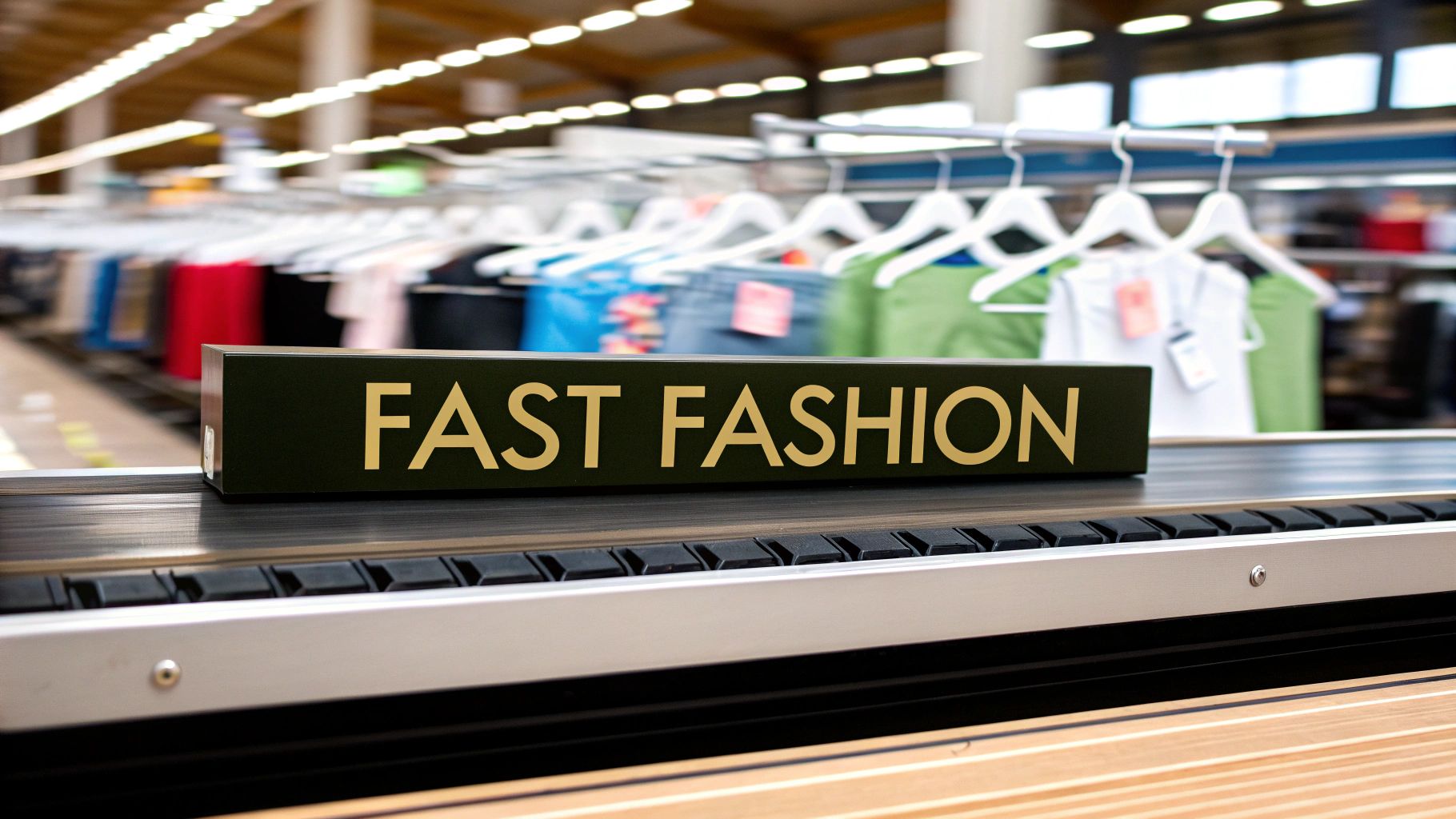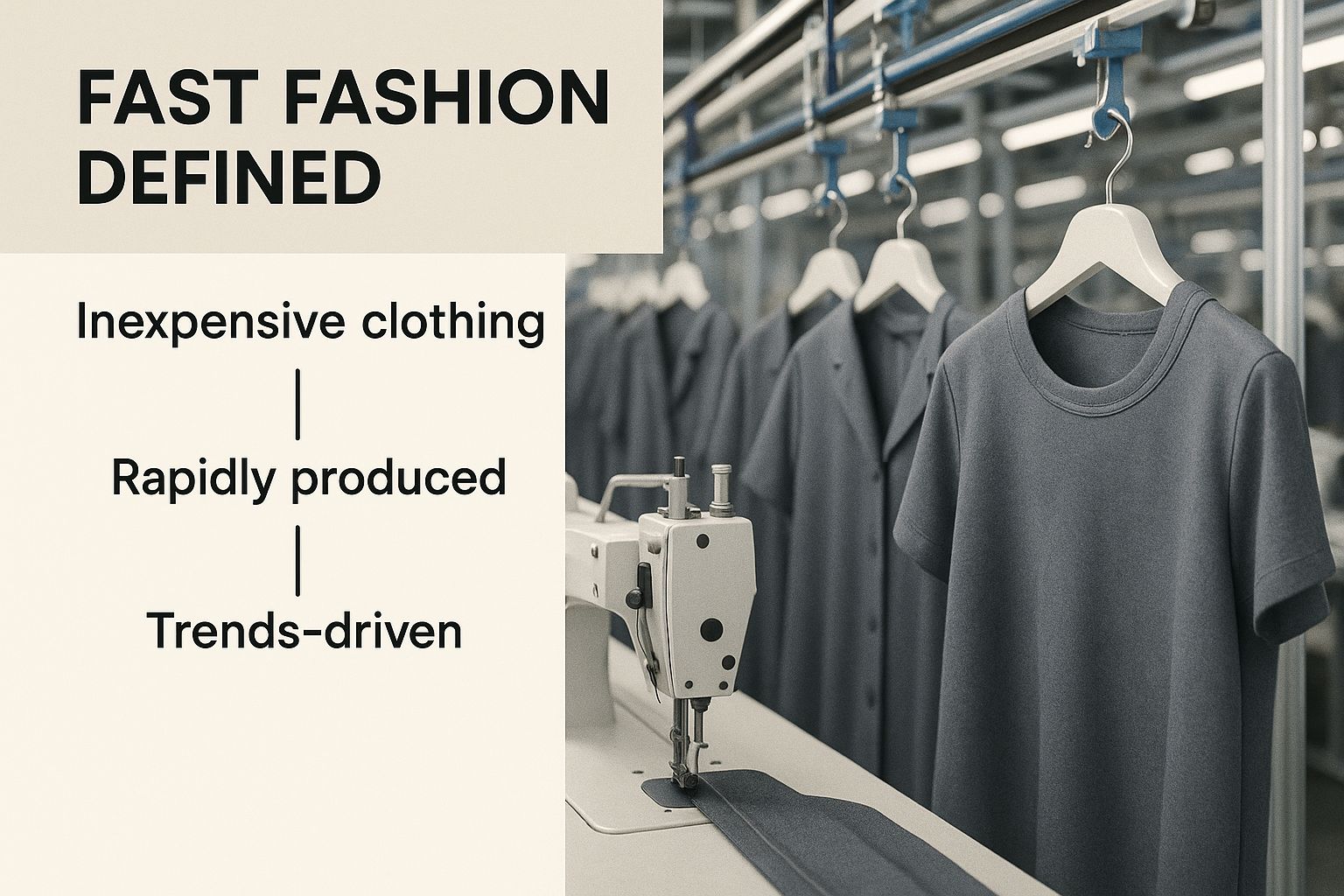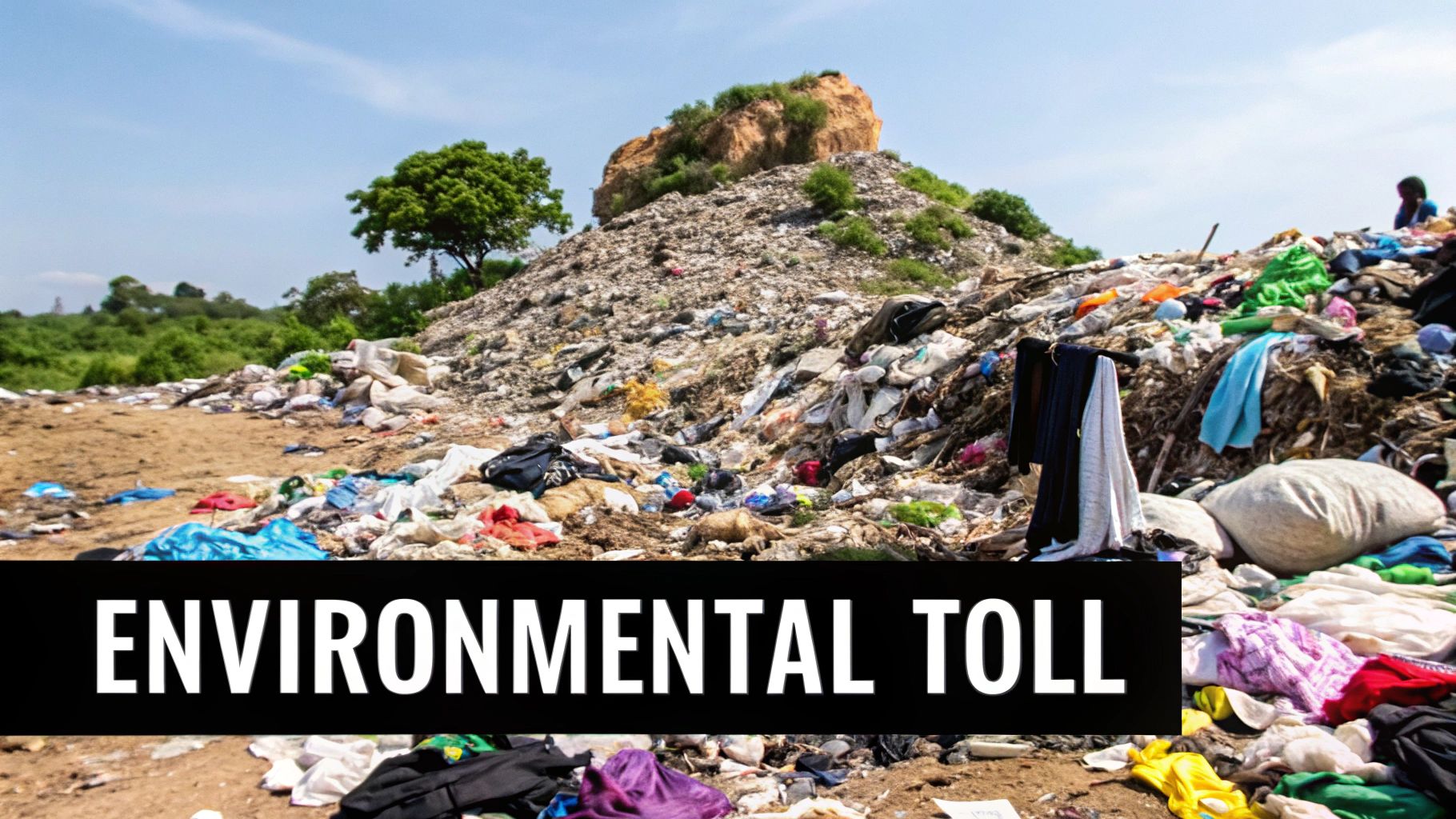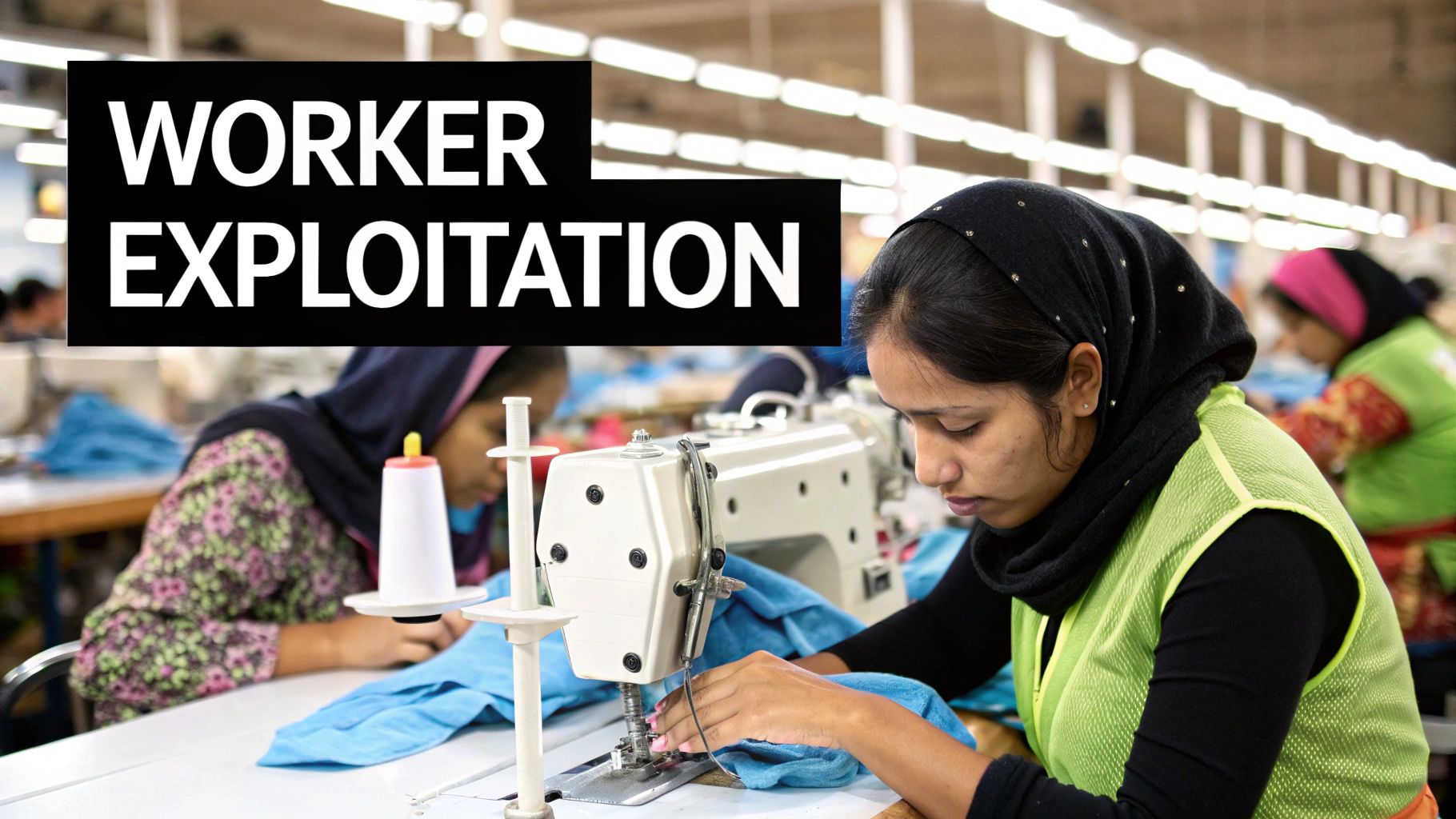
Fast fashion is a term you've probably heard a lot, but what does it really mean? The easiest way to think about it is like fast food for your wardrobe. It’s quick, cheap, and trendy, but just like a burger and fries, it often lacks quality and comes with some serious hidden costs—for both the planet and the people making the clothes.
At its heart, fast fashion is a business model built on speed. It’s all about getting designs from the catwalk or a celebrity's Instagram feed into stores and onto your back in a matter of weeks, not months.
Decoding the Fast Fashion Business Model
Traditional fashion brands work in seasons, planning collections far in advance. Fast fashion threw that rulebook out the window. Instead, they can drop new collections every single week, creating a constant feeling that you need to buy now before it's gone. This creates a powerful sense of urgency for shoppers.
This entire system rests on a few core principles:
- Blazing Speed: Brands use data to pinpoint what's trending right this second and then rush those designs into production.
- Massive Volume: To drive prices down, they produce clothing on an almost unbelievable scale.
- Rock-Bottom Prices: The end goal is to make trendy clothes so affordable they feel almost disposable.
The Scale and Speed of Production
The pace is just relentless. A dress worn by an influencer today can be designed, produced, and hanging in a store for you to buy in just a few days. This incredible agility is central to the whole operation, and it lines up perfectly with the modern shopper's desire for instant gratification. This cycle is deeply connected to the current trends in retail, which increasingly favor speed and novelty.
This process has turned fashion into a high-speed assembly line.

The image above really drives home how the industry is structured for maximum output, transforming fleeting trends into tangible products at a dizzying rate. It’s a system that has ballooned into a global behemoth.
The fast fashion market was valued at around $122.98 billion in 2023 and is projected to hit $283.47 billion by 2033.
That staggering growth isn't just a business statistic; it reflects a massive shift in how we think about our clothes. We've moved from treating garments as durable goods to seeing them as consumable items, worn a few times and then tossed aside. This explosive expansion is the key to understanding the model's wider economic and environmental footprint.
To make the differences crystal clear, let's look at how this new model stacks up against the old way of doing things.
Fast Fashion vs Traditional Fashion At a Glance
The table below breaks down the fundamental distinctions between the two models. It’s a quick snapshot that highlights the core differences in everything from production cycles to quality.
| Characteristic | Fast Fashion | Traditional Fashion |
|---|---|---|
| Production Cycle | 2-4 weeks from design to store | 6-12 months with seasonal collections |
| Trend Response | Immediate, reacting to micro-trends | Planned, based on long-term forecasts |
| Price Point | Very low, encouraging impulse buys | Higher, reflecting quality and design |
| Quality & Durability | Low, designed for short-term wear | High, intended to last for years |
| Number of Collections | 50-100+ "micro-seasons" per year | 2-4 seasons per year (Spring/Summer, Fall/Winter) |
| Supply Chain | Complex and often opaque | More direct and often traceable |
As you can see, the two approaches are worlds apart. Fast fashion prioritizes speed and volume above all else, while traditional fashion has historically focused on craftsmanship and longevity. This fundamental clash sets the stage for many of the issues we'll explore next.
From Seasonal Collections to Weekly Drops
If you rewind the clock just a few decades, the fashion industry moved at a completely different pace. It ran on a predictable, biannual rhythm with two main events: the Spring/Summer collection and the Fall/Winter collection. That was it. This traditional model gave trends time to develop and gave clothing a sense of permanence. We bought pieces with the expectation they would last.
But then, the groundwork started to shift. Thanks to major changes in global manufacturing and logistics, brands discovered they could produce clothing much faster and cheaper than ever before. Suddenly, that old six-month production cycle felt clunky and slow. This new capability opened the door to completely reinventing how fashion gets from the design sketch to your closet.
The Rise of Micro-Seasons
Pioneering brands, with Zara leading the charge, saw a huge opportunity to break the old system. Instead of trying to guess what we'd want to wear six months from now, they flipped the model on its head. They started using an agile "test and repeat" strategy.
Here's how it worked:
- They’d release a small batch of a new design.
- They'd watch the sales data like a hawk.
- If an item was a hit, they'd rush a massive order into production immediately.
This was the birth of micro-seasons, and it was a total game-changer. The industry went from two seasons a year to 52 or more. New items, or "drops," started landing in stores every single week, and it completely rewired how we think about shopping.
The real innovation wasn't just making clothes faster. It was shrinking the time between seeing a trend, wanting it, and finding it on a store rack. A process that once took months now happened in a few short weeks, creating a constant, churning cycle of newness.
This flood of new products did more than just fill the racks; it created a powerful psychological pull. Shoppers started feeling a very real "fear of missing out" (FOMO). You knew if you didn't buy that top right now, it would probably be gone by next week, replaced by something else. That manufactured sense of urgency quickly became the cornerstone of the fast fashion business model.
The New Consumer Mindset
This wasn't just a change in logistics; it was a cultural overhaul. As clothes got cheaper and more abundant, the way we valued them plummeted. The focus shifted away from quality and durability and landed squarely on novelty and being on-trend.
We were trained to want an endless parade of new styles at rock-bottom prices. This mindset created the perfect environment for today's fast fashion giants to build their empires, successfully turning clothing from a durable good into a disposable one. The industry didn't just speed up production—it sped up desire itself.
Inside the High-Speed Production Machine

The fast fashion model is a masterclass in speed, a well-oiled machine built to turn an online trend into a tangible garment hanging in your closet at a dizzying pace. To really understand what is fast fashion, you have to look under the hood at its operational core. The process doesn't start with a designer's sketch; it starts with data.
Brands are constantly scanning social media, tracking celebrity style, and monitoring runway shows with sophisticated algorithms. These tools pinpoint emerging colors, silhouettes, and aesthetics the second they start bubbling up. This digital-first approach takes the guesswork out of design, letting brands create styles that already have a built-in audience before a single thread is sewn.
From there, this data-driven design flows seamlessly into a supercharged production cycle.
From Digital Trend to Physical Product
Once a hot trend is flagged, the race is on. The entire system is built for agility, completely shredding the traditional, season-based fashion calendar and replacing it with a series of rapid-fire steps.
- Rapid Prototyping: Digital designs are transformed into physical samples in just a few days.
- Small-Batch Testing: Instead of betting the farm on one big production run, brands release small initial quantities to test the waters in key markets.
- Real-Time Sales Analysis: The moment those first items go live, sales data is tracked obsessively. Best-sellers are immediately flagged for massive reorders.
- Agile Supply Chains: To make this happen, brands maintain a flexible network of factories, often located close to their primary markets, to enable lightning-fast turnarounds.
This "test and repeat" model is the beating heart of fast fashion. It cuts down on the risk of being stuck with warehouses full of unwanted clothes and ramps up profitability by going all-in on proven hits. It’s a powerful feedback loop where what you buy today directly dictates what gets produced tomorrow, feeding an insatiable cycle of newness.
The core operational principle is simple yet incredibly effective: Use real-time data to make small bets, find the winners, and then scale production massively. This minimizes waste from unsold inventory while maximizing the capture of fleeting trends.
The Engine of Constant Demand
Of course, high-speed production needs high-speed marketing to match. Flash sales, limited-time drops, and influencer hauls create a constant feeling of urgency. The marketing screams, "Buy it now, or it'll be gone forever!"
This operational velocity is what has fueled the industry's explosive growth. The market is expected to surge from around USD 163 billion to over USD 214 billion between 2024 and 2029. A key factor behind this growth is the rising global youth population—the primary audience for these trendy, affordable clothes. You can dig deeper into these numbers in a report from Technavio on PR Newswire.
Ultimately, the entire machine is engineered to close the gap between seeing something you want and owning it. By collapsing the design, manufacturing, and marketing timelines into a matter of weeks, fast fashion has completely rewired our relationship with clothing, making volume and velocity the new metrics for success.
The Hidden Environmental and Social Costs

That appealingly low price tag on a new shirt or dress? It hides a much steeper cost—one paid by our planet and the people who make our clothes. While the speed and accessibility are what we see at the checkout, the true impact of this high-volume production model stays hidden. To really understand what is fast fashion, we have to pull back the curtain on its profound environmental and social consequences.
The industry's environmental footprint is just staggering. Think about what it takes to make a single piece of clothing: the immense amount of water needed to grow cotton, the toxic chemical dyes that pollute rivers, and the energy to run the factories. Then there's the rise of synthetic fabrics like polyester, which has introduced a whole new problem: microplastic pollution. Every time you wash these clothes, they shed tiny plastic fibers that flow straight into our oceans, harming marine life and eventually entering our own food chain.
The Planetary Toll of Disposable Clothing
The damage doesn't stop once the clothes are made. The entire business model is built on disposability, which has created a monumental waste crisis. With trends changing in the blink of an eye, garments are often worn just a handful of times before being tossed aside, overwhelming donation centers and piling up in landfills at a frightening rate.
Back in 2018, the Environmental Protection Agency (EPA) found that a shocking 66% of all discarded textiles in the U.S. were sent straight to landfills. Once there, they don't just biodegrade peacefully.
- Greenhouse Gas Emissions: As all those clothes break down, they release methane, a powerful greenhouse gas that significantly contributes to climate change.
- Chemical Leaching: The dyes and finishing chemicals—including PFAS, the notorious "forever chemicals"—can seep into the soil and groundwater, threatening ecosystems and human health.
- Microplastic Contamination: Since about 60% of our clothing contains plastic, landfills become long-term sources of microplastic pollution that persists for centuries.
This relentless cycle of "make, wear, toss" has massive global consequences. The fast fashion industry is estimated to be responsible for 2% to 8% of global greenhouse gas emissions and around 20% of all industrial wastewater worldwide. These figures, which you can explore further in this analysis on the fashion industry's growth at LaticoLeathers.com, paint a stark picture of an industry at odds with planetary health.
The cheap price of a fast fashion garment is not its true cost. The real price is paid through polluted water, overflowing landfills, and a destabilized climate. It’s a debt we pass on to the planet.
Let's break down what these impacts look like for a single, seemingly harmless piece of clothing.
The Hidden Costs of a $10 T-Shirt
This table breaks down the environmental and social impacts associated with producing a single, low-cost garment, illustrating the far-reaching consequences of fast fashion on a tangible scale.
| Impact Area | Example Consequence | Statistic/Fact |
|---|---|---|
| Water Consumption | Growing the cotton for one t-shirt can use up to 2,700 liters of water—enough for one person to drink for 2.5 years. | |
| Chemical Pollution | Runoff from toxic dyes used to color the fabric contaminates local drinking water sources for communities near factories. | The textile industry is the second-largest polluter of water globally. |
| Carbon Emissions | Energy-intensive manufacturing and global shipping from Asia to Western markets produce significant CO2. | The fashion industry produces more emissions than international flights and maritime shipping combined. |
| Landfill Waste | The t-shirt is often discarded after just a few wears, contributing to textile waste that can take 200+ years to decompose. | The average American throws away about 81 pounds of clothing every year. |
| Human Labor | Garment workers may be paid just a few cents per shirt, working long hours in unsafe conditions to meet production quotas. | In many regions, garment workers earn less than half of the calculated living wage. |
Seeing the numbers laid out like this makes it clear that there's no such thing as a "cheap" t-shirt. The real cost is simply paid by someone, or somewhere, else.
The Human Cost Behind the Label
Beyond the environmental devastation lies a deeply troubling human story. To keep prices impossibly low, fast fashion brands often rely on a global network of factories where labor rights are an afterthought. The constant pressure to produce clothing faster and cheaper creates conditions ripe for exploitation.
Reports from garment-producing nations consistently uncover the same issues: poverty-level wages, forced and excessive overtime, and dangerously unsafe working conditions. The tragic 2013 collapse of the Rana Plaza factory in Bangladesh, which killed over 1,100 workers, cast a harsh spotlight on these systemic failures. While that disaster sparked some reforms, the fundamental pressures of the fast fashion model continue to place garment workers directly in harm's way.
Ultimately, these hidden costs are woven into every thread of a low-cost garment. Each purchase decision props up a system that extracts a heavy price from both our planet’s finite resources and the vulnerable people within its supply chains.
Recognizing Fast Fashion Brands in the Wild
It’s one thing to talk about the fast fashion model, but it’s another to see it working in real time while you’re scrolling online or walking through the mall. Learning to spot these brands is the first real step you can take toward making more mindful choices. This isn't about shaming anyone's shopping habits—it's about pulling back the curtain on their business strategies.
Think about it: many of the biggest names in retail are, in fact, titans of the fast fashion world. Household names like Zara, H&M, Shein, and Fashion Nova didn't get to the top by accident. They've perfected the art of creating a constant, nagging desire for newness, turning a trend you saw on TikTok this morning into an affordable top you can buy by lunchtime.
Decoding the Giants' Playbooks
Each of these major players has its own secret sauce. Zara, for example, is legendary for its lightning-fast supply chain. It can take a design from a high-fashion runway and have it hanging in its stores in just a few weeks, capturing a trend at its absolute peak.
H&M plays a slightly different game, building enormous hype through high-profile designer collaborations. These limited-edition drops create a frenzy, making luxury fashion feel accessible for a fleeting moment and getting people through the door.
Then you have the newer, online-only behemoths:
- Shein: This digital giant uses massive amounts of data to figure out what you want before you even know you want it, churning out thousands of new styles every single day.
- Fashion Nova: It built its kingdom on the back of social media, using an army of influencers to market its clothes to millions of followers instantly.
These companies aren't just selling clothes. They're selling speed, accessibility, and the thrill of being perfectly on-trend. Their entire model is built on making you feel like the latest style is just one click away and far too cheap to resist.
Making More Informed Choices
Once you know what to look for, these strategies become obvious. When you see a store with new arrivals every single week, unbelievably low prices, and clothes that look exactly like what you just saw on your favorite celebrity, you're almost certainly looking at a fast fashion brand.
Knowing this helps you look past the tempting price tag and think about the bigger picture.
Luckily, choosing an alternative doesn't have to be a huge, expensive leap. For many people, the path away from fast fashion starts with giving pre-loved clothes a second chance. Learning how to thrift shop can be a game-changer, opening up a world of unique, often better-quality pieces for a fraction of the price and directly challenging the "wear once, then toss" mindset.
Choosing Sustainable Alternatives That Last
Knowing what’s wrong with fast fashion is one thing, but figuring out how to actually do something about it is where the real change happens. The good news? You don't have to empty your bank account or get rid of everything you own overnight. It all starts with a simple shift in perspective: from seeing clothes as disposable trends to investing in durable, lasting style.
This is the entire philosophy behind the slow fashion movement. If fast fashion is a frantic sprint, think of slow fashion as a thoughtful, steady walk. It’s an approach built on buying less but choosing pieces that are made to last—valuing quality craftsmanship, ethical production, and timeless designs you’ll reach for years from now, not just for the next few weeks.
Embracing a More Mindful Wardrobe
Taking a slower approach to your closet can look different for everyone, and that’s the beauty of it. There isn't a rigid rulebook to follow. It's about finding what feels right for you and your lifestyle. To make a real impact, it helps to understand the fundamental differences and impacts of slow fashion vs. fast fashion.
Here are a few practical places to start:
- Become a Thrifter: Hitting up a secondhand shop is easily one of the most sustainable and budget-friendly ways to build a wardrobe that’s uniquely you. It gives clothes a second chance, keeping them out of the landfill.
- Support Ethical Brands: Seek out companies that are open about how and where their clothes are made. These brands usually focus on fair wages for workers and use sustainable materials, which might mean a higher price tag upfront, but it's a price that reflects true cost.
- Learn to Mend: A missing button or a small rip doesn't have to be a death sentence for a favorite shirt. Picking up a few basic sewing skills can drastically extend the life of your clothes, which saves you money and cuts down on waste.
Making this change completely transforms how you feel about your closet. It stops being a revolving door of cheap, temporary thrills and becomes a curated collection of clothes you genuinely love and value.
A core concept in sustainable style is "cost per wear." A well-made $100 coat you wear 100 times really only costs $1 each time you put it on. That trendy $20 top you wear twice? That's $10 per wear. Suddenly, the higher-quality item looks like the smarter financial choice.
Building this kind of wardrobe is a journey, not a race. Our guide on how to shop sustainably dives deeper into strategies for making more thoughtful purchases. Ultimately, the goal is to evolve from an impulse-driven consumer into a conscious owner of a wardrobe built to last.
Answering Your Toughest Fast Fashion Questions
Trying to navigate the world of sustainable fashion can feel like wading through mud. There's a ton of conflicting information, and it's easy to get stuck. Let's tackle some of the most common questions and clear up a few gray areas.
Can a Fast Fashion Brand Ever Be Truly Sustainable?
This is the big one. We see fast fashion giants launching "conscious" or "eco-friendly" collections all the time. But can a brand built on speed and volume ever be genuinely sustainable? The short answer is: it’s a fundamental conflict.
Their entire business model relies on producing massive quantities of clothing at lightning speed to chase fleeting trends. While a collection made from recycled polyester is a step, it doesn't change the underlying system of overproduction and disposability. Critics rightly call this greenwashing—when a company spends more time and money marketing its green credentials than actually minimizing its environmental impact.
For a brand to make a genuine shift, it would have to fundamentally change its DNA. It would mean slowing down, producing less, and encouraging customers to buy for keeps, not just for a season.
How to Spot Greenwashing in the Wild
So, how do you separate the real deal from clever marketing? It comes down to looking for proof, not just promises.
- Demand Transparency: Genuinely sustainable brands aren't shy about their supply chains. They'll tell you where their clothes are made. Look for third-party certifications that do the vetting for you, like Fair Trade, GOTS (Global Organic Textile Standard), or B Corp.
- Question Vague Language: Be skeptical of fuzzy, feel-good words like "eco," "green," or "mindful" if they aren't backed up with specifics. If a brand can't tell you how a product is sustainable, it probably isn't.
But Isn't Sustainable Fashion Just Too Expensive?
This is a huge myth that needs busting. Yes, the upfront cost of a well-made garment from an ethical brand is often higher than a $10 t-shirt. But the real story is in the cost per wear.
Think about it: that one high-quality, ethically-made jacket you buy for $200 might last you a decade. You could wear it hundreds of times. Meanwhile, a $40 fast fashion alternative might fall apart after one season, forcing you to buy another, and another. In the long run, investing in quality is often the more frugal choice.
Plus, sustainable fashion isn't just about buying new. It’s a whole mindset that includes thrift shopping, mending what you own, and participating in clothing swaps—all of which are incredibly budget-friendly ways to build a wardrobe you love.










